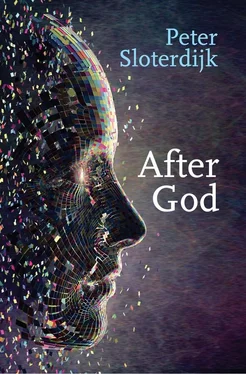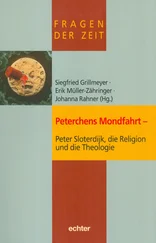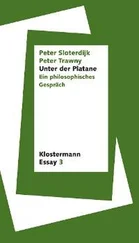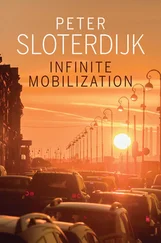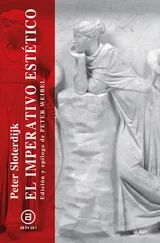*
In the reductionism of the fledgling Reformation during the Luther era, energetic activity and the extreme ability to do nothing became entangled in a manner almost unparalleled in the history of ideas and of the soul. The reduction proceeds from the now firmly internalized evidence that sacrifices and courtesies cannot sway the incorruptible Highest. The only method of drawing the absolute to one’s side consists in delivering oneself to him wholly, as the mystics teach – in the West and East alike. Yet, as long as the gesture of self-deliverance remains a self-conscious act, it would be, for its part, nothing more than a speculative transaction with an increased wager: it would trade blood sacrifice for self-sacrifice. It would seek to domesticate the absolute by fusing with it. This diagnosis would, however, be accurate only so long as one were dealing with an inert absolute. A communicative absolute could have preempted the human attempt at encounter. In the linguistic space of western ecumenism, such a scoop is called “Christ.” His love would be the unmerited thing that cannot be compelled, no matter how great the effort.
Following the Augustinian schema of revolt in heaven, Protestant reductionism is content to simplify the issue of God into an eccentric love story. In a nutshell, one day human beings stopped placing God above all things, because they decided to emulate the example of Satan and chose themselves as the object of their predilection. In doing so, they warped ordo amoris [the order of love] to a point beyond repair. In contrast, God continues to love human beings, albeit not without placing certain conditions on them. If they turn back with enough remorse, they should be welcome. If they remain as they are, their damnation is irreversible.
Whoever espouses this screenplay as an interpretation of her being in the world must brace herself for complications. The young Luther read himself into this scenario, under pressure from his pre-religious, existential mood of disgruntlement. He could not guess that the schema of the troubled love story was elaborated without exception within high cultures. According to this schema, the lovers originally belong together, but must become estranged and fail for some unknowable reason. The young Luther obviously brought into play a high potential that was set up for estrangement and failure. In modern parlance, one would call his point of departure a severe neurosis. It became historically decisive that Luther’s disturbed state was suited for a recoding of religion, and even more for a religious–political translation.
We should not see it as an accident that Luther first made a name for himself by handling the question of how to deal with the facts of guilt, penance, and despair. All in all, the October 1517 theses on indulgences represent no more than zealous – and, seen from a historical distance, hairsplitting – statements on questions about the external and internal administration of penance.
Luther drops the air of nitpicking in three of his theses, however. They concern the human’s acute despair of himself, a despair that does not allow him to assume two positions at the same time. Some of the theses read as though they were a proleptic answer to Plessner’s theorem on the eccentric positionality of the human being: when the individual, once compacted into a single point, hears that human existence and doing penance should become the same, he feels subject to Jesus’s saying, Poenitentiam agite etc. [ sic ] [Repent etc. [ sic ]]. 25Technically and from the perspective of the disputation, Luther had already won with his first thesis. In the form of a dominical saying (from Matthew 4:17), it recalls the price one must pay for God’s accommodation. If the Highest steps toward you, everything else is just padding.
The entire program of the Reformation is contained in the reference to unpurchasable and unmanipulable penance, in which no one can stand in for another. From then on Luther has the privilege of being certain of his orthodoxy. What remains is formalities. It requires almost no effort to dismantle the industry of indulgences in the papal church as a suspect fabrication, concocted by hypocrites for the use of hypocrites.
“Man” is even more starkly reduced to a single point when he experiences how horror [the horror] of dying anticipates horror of the purgatorial fire. In the terror of the last hour, the otherworldly flames encroach upon this world. Here Luther indirectly picks up on the motif of humans gaining wisdom when it is too late. The fifteenth thesis leaves no doubt about the gravity of the situation: Hic timor et horror satis est se solo … facere penam purgatorii, cum sit proximus desperationis horrori . “This fear or horror is sufficient in itself … to constitute the penalty of purgatory, since it is very near to the horror of despair.” 26We cannot say for certain whether, at the time of writing this, Luther had already stood at the bedside of someone dying. What is certain is that he is speaking of himself in this passage. His effort to find a strong foothold in the abyss culminates in the sixteenth thesis, where he brings the problem of penance to a head:
Hell, purgatory, and heaven seem to differ the same as despair, half despair, and assurance of salvation.
Videntur infernus, purgatorium, celum differe sicut desperatio, prope desparatio, securitas differunt . 27
The reduction hits the target with this distinction between different grades of despair. The seemingly harmless prope (“near,” “well nigh,” “nearby”) turns out to be the cardinal point in the radicalized interpretation of faith. Because near despair on Earth is distinct from complete despair in hell, even if only slightly at first blush, there is still a remainder of hope for later security. Whenever such hope is alive, the human being moves about in a middle zone. What one calls faith is actually the oscillation between extremes. Pastoral ministry has a term for it: Anfechtung [affliction, trial, tribulation]. The possibility of the human’s salvation is hidden away in the inconspicuous word “near.” Whoever only almost despairs can just as well undertake to be confident.
The successful reduction immediately gives rise to a dissolution of boundaries: If human existence is to become an integral exercise in penance, the purifying event will already be occurring, here and everywhere. Besides baptism no special access is needed. The cobbler, the smith, the farmer – they are all ordained priests and bishops. The spiritual privilege of the monastic form of life falls to the wayside. Luther democratizes the state of semi-despair. He indicates that the cleric is not saved a priori – not an ounce more than laypeople are. Now the motto holds: Purgatory for all, and right away at that, not after death! The extremes of heaven and hell, together with their reflections in definitive certainty and complete despair, lose all their lifeworld and everyday practical meaning. They remain the province of eschatological speculation and artistic depiction.
The Reformation is thus based on a relocation of the purgatorial function to the earlier stage of earthly existence. Concomitant with this is an expansion of penitential existence. If the cloister and the lifeworld have become one, it no longer makes sense to join a monastery. The clergy is no longer an independent estate. This is related to the observation that the later Luther still speaks of purgatory only rarely, and in the end almost not at all. In a sense, he is in a position where he no longer needs it; for it has been replaced by existence in the flames of the everyday. He no longer feels the dogmatic pressure to presuppose it as an established third location in the otherworldly realm either. Moreover, God himself would turn out to be a protector of ecclesiastical hypocrisy if he tolerated the emergence, from either–or, of an all too comfortable both–and. Purgatory is indeed a compositum mixtum , a mixed compound that serves as an antechamber to heaven ontologically, all the while resembling hell phenomenologically. The older Luther seems to think that, if such a place were to exist, it could only be demonstrated in human life. Human existence is in fact the intermingling of pre-hell and pre-heaven. Whoever knows the proper fear of death has no need of a transcendent purgatory. In 1928, Martin Heidegger said that Dasein means being held out into nothingness – as though, for the last time, we can hear in this an echo of Luther’s admonition that, when properly conceived of, existence qua existence is a purifying fire.
Читать дальше
